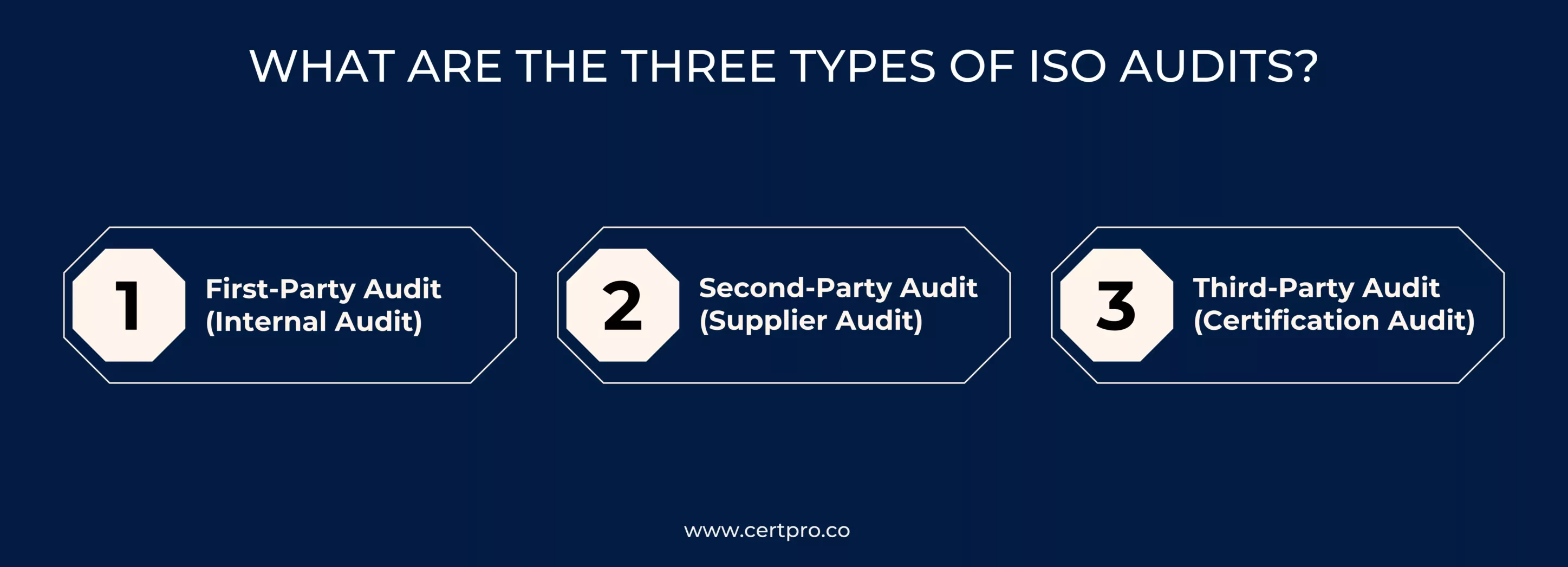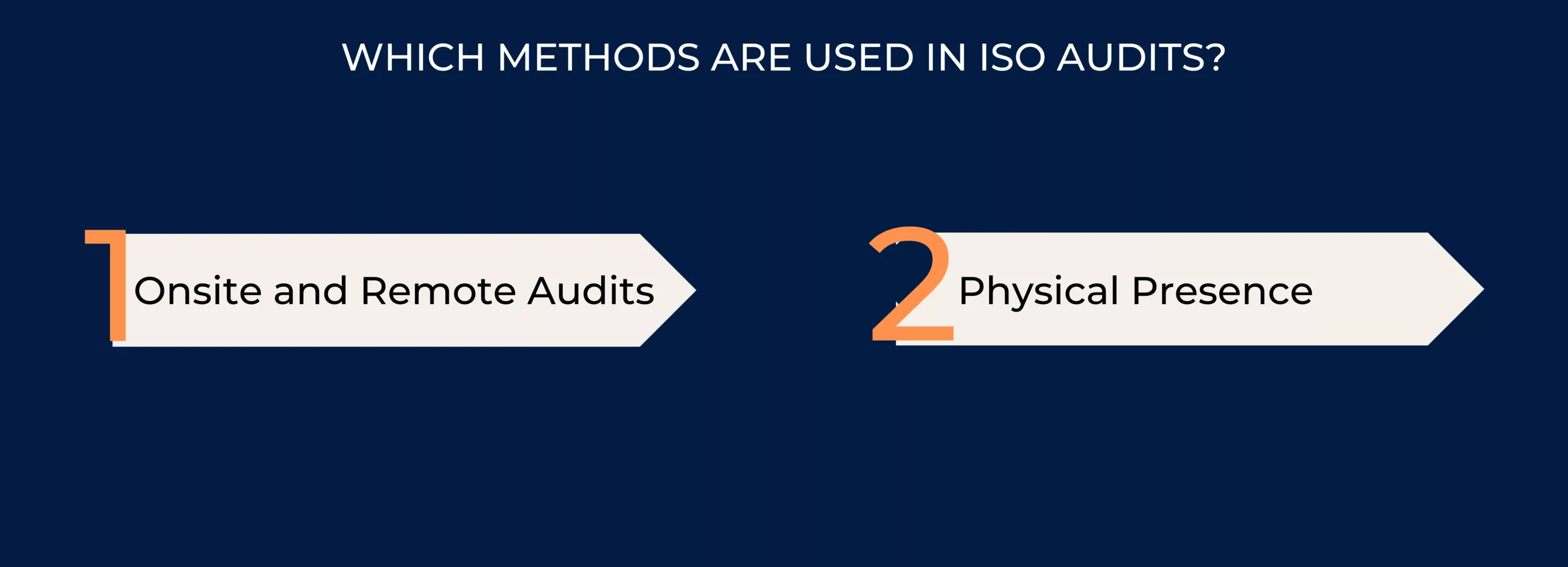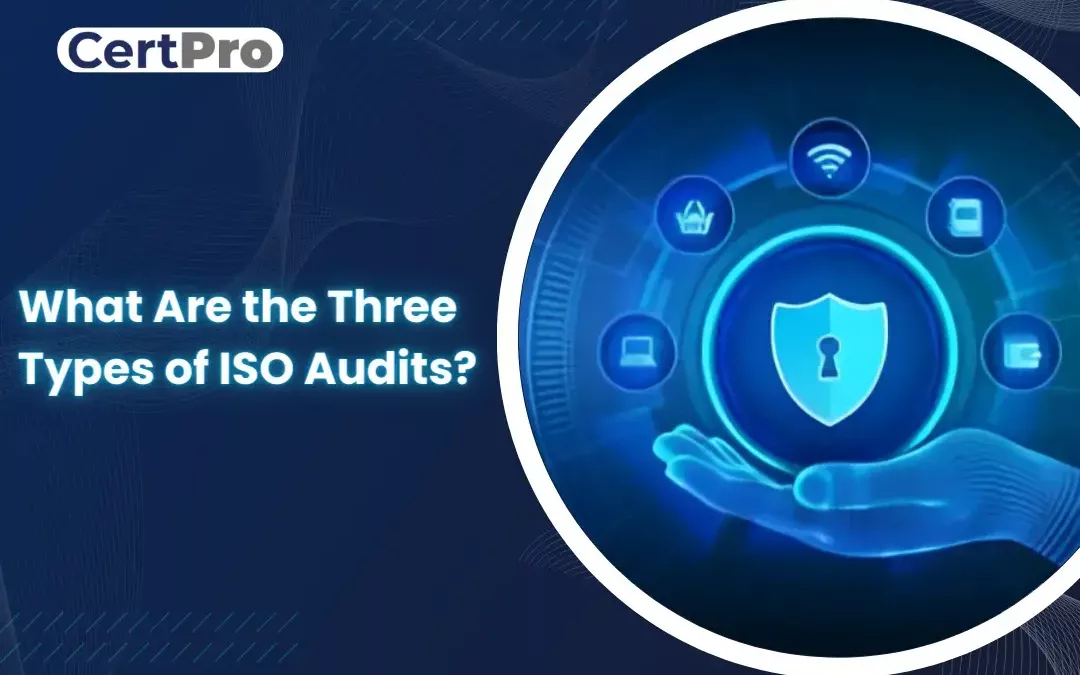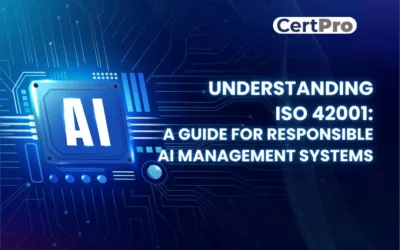The International Organization for Standardization (ISO) is at the forefront of global standards creation, with the purpose of establishing industry-wide benchmarks to ensure the safety, efficiency, and sustainability of our products and processes. Within ISO’s vast database, you’ll find well-known standards like ISO 27001 and ISO 9001, which not only serve as the foundation of best practices but also open the door to certification. Participating in ISO audits is a strategic step that can generate diverse benefits for your organization, whether your goal is to obtain an ISO certification or simply to have the peace of mind that comes with complying with ISO standards.
This article will serve as your all-encompassing guide to ISO audits. It has been specifically created to provide you with critical insights into ISO audit types, explain the various types of ISO audits, and provide you with an insightful ISO audit checklist, easing your readiness for both internal and external ISO audit types. ISO audits, which play a critical role in maintaining the highest standard of quality, safety, and environmental responsibility within enterprises, have emerged as a must-have instrument for success. Over the next few pages, we’ll delve into the heart of ISO audits, focusing on the three types of audits that play a critical role in guiding businesses toward ISO compliance and operational excellence.
WHAT IS THE PURPOSE OF AN ISO AUDIT?
An ISO audit types evaluates your organization’s compliance with International Organization for Standardization (ISO) standards. ISO, a non-governmental organization based in Geneva, Switzerland, develops international standards and control frameworks to oversee best practices in a variety of industries, ranging from information security to environmental management. ISO is committed to supporting continual improvement, and each standard is reviewed every five years to ensure relevance. An ISO audit checklist compares your company’s systems to a specific ISO standard, and getting ISO certification for some standards requires a third-party audit. Among the notable ISO standards that can be ISO certified are:
- ISO 9001: Quality Management Systems (QMS)
- ISO/IEC 27001: Information Security Management Systems (ISMS)
- ISO 14001: Environmental Management Systems
- ISO 50001: Energy Management Systems (EnMS)
- ISO 45001: Occupational Health and Safety Management Systems
- ISO 13485: Medical Devices
- ISO 22000: Food Safety Management
While ISO compliance requires aligning practices, procedures, and policies with specific ISO standards and may include internal audits, ISO certification goes a step further. Qualified ISO auditors perform formal third-party audits as part of the process. Compliance and certification reflect a company’s dedication to quality and conformity to internationally recognized standards.
WHAT ARE THE THREE TYPES OF ISO AUDITS?
There are three types of ISO audits: internal audits (first-party audits), supplier audits (second-party audits), and external audits (third-party audits). Your choice of audit type depends on your compliance and certification goals, as well as the scale, scope, and budget of your organization. Remember that ISO certification demands collaboration with an external, third-party auditor with the necessary qualifications to conduct the audit. While many ISO standards are accountable, it is critical to specify the scope and goal of the audit effort. An audit designed to evaluate an organization’s quality system, Quality Management System (QMS), and quality policies may not be the best fit for investigating other regulatory obligations. A well-planned audit, on the other hand, can address several compliance elements, especially if there is an overlap between controls. Pay attention to the possibility of integrating compatible compliance initiatives, which can save your company time and money.
1. First-Party Audit (Internal Audit): An internal ISO audit involves hiring a designated auditor from within your organization. If ISO compliance is your primary goal, an internal audit can guarantee that your organization uses ISO standards as a baseline for best practices. Use an internal audit checklist to determine how your organization’s systems compare to ISO standards. Internal audits lay the framework for certification, surveillance, and recertification audits.
As with any internal audit endeavor, a business should include some type of management review in the audit’s results. This evaluation identifies areas that require corrective action and keeps leadership up to date on compliance activities. Importantly, the audit results should be circulated to the appropriate stakeholders in order to build a culture of continuous development. This approach applies to all sorts of audits, not just internal audits.
2. Second-Party Audit (Supplier Audit): The second type of ISO audit is known as a second-party audit, sometimes known as a supplier audit. In this context, an organization, usually the customer, evaluates its suppliers or vendors. The major goal is to ensure that these providers are in compliance with the specified ISO standards and regulations. Supplier audits are critical in today’s interconnected business landscape, as several firms rely on one another for critical services, resources, and products. Risks arising from non-compliant or compromised suppliers can quickly transfer into risks for the purchasing organization, especially when such suppliers have a long history with the business. Several recent cybersecurity breaches, it’s essential to note, were not initiated within the target firm but instead resulted from vulnerabilities within their supplier network. As a result, performing supplier audits becomes an essential step in achieving and maintaining ISO compliance, as well as a helpful best practice for organizations that rely significantly on suppliers for day-to-day operations.
3. Third-Party Audit (Certification Audit):A third-party audit, often known as a certification audit, is an independent external examination carried out by a certifying authority or registrar. Its major goal is to determine whether an organization is eligible for ISO certification or recertification. Passing a third-party audit successfully results in the desired ISO certification, indicating to consumers and stakeholders that the firm strictly complies with ISO criteria.
ISO audits, including internal, supplier, and external types, serve vital functions. They assess a company’s compliance with ISO standards, offering an unbiased perspective that assures stakeholders of impartiality. Utilizing a well-structured ISO audit checklist enhances the process’s effectiveness. ISO certification achieved through third-party audits bolsters credibility, demonstrating dedication to quality, consumer satisfaction, and regulatory standards. This commitment elevates a company’s reputation and competitive position. In essence, ISO audit types play a pivotal role in showcasing an organization’s commitment to quality and compliance, ultimately contributing to its success in a competitive market.

WHY IS AN ISO AUDIT NEEDED?
Corporations use diverse instruments, such as ISO audit types, to ensure conformity with ISO standards and enhance operations. These audits serve as diagnostic tests, assessing an organization’s compliance with ISO regulations and highlighting operational flaws. This useful understanding serves as the cornerstone for comprehensive risk management methods, allowing firms to handle possible issues in advance.
ISO audit checklists play a vital role in identifying non-compliance areas and supporting corrective measures aligned with ISO standards to improve overall performance. ISO audit checklists contribute to proactive risk assessment and the creation of new systems and strategies to effectively navigate developing business landscapes. A well-planned audit timetable can accelerate a company toward ISO certification, opening up new markets and prospects. ISO audit types, in essence, function as dynamic tools that ensure present compliance, promote continuous improvement, and build the path for future success.
WHICH METHODS ARE USED IN ISO AUDITS?
Depending on the particular audit type and the particular needs of the company, there may be differences in the methodology used to perform ISO audits. An overview of the many approaches used to carry out ISO audits is provided below, with consideration given to the unique qualities of each audit type and their alignment with the particular requirements of the company.
1. Onsite and Remote Audits: ISO audits can be carried out remotely or locally, depending on the type of audit. The organization itself may conduct internal audits remotely or on-site. While some external audits can be done online, registrars are still required to perform certification and surveillance audits in person.
2. Physical Presence: In cases where organizations operate entirely electronically or remotely, discussions with external auditors are required to assess whether a remote audit is sufficient or if plans for onsite auditors are required.

TIME FRAME FOR ISO CERTIFICATION
The time it takes to become ISO certified is a variable period that depends on an organization’s preparation level, previous preparation, team size, and operational scope. For organizations that are starting from scratch or that require extensive system changes, more time is needed than for those that already have compliance frameworks in place. A reasonable estimate for the time it takes to prepare for the first certification audit is three to six months. During this time, a series of internal audits will be conducted, together with possible client and supplier audits, to create a comprehensive plan for successfully meeting the certification requirements.
PREPARING FOR AN ISO AUDIT
A successful and efficient audit process depends on careful planning, which is a crucial part of preparing for an ISO audit. Every audit is not only a useful stepping stone for further audits, but it also evaluates compliance. The following five tips can help you prepare better for your ISO audit:
Define your objectives: Start by stating your goals and intended results in precise terms. When designing your audit timetable, keep in mind that certification is your ultimate objective. Aligning your efforts with your certification objectives will maximize the use of your resources.
Develop a structured audit schedule: Make an organized audit schedule with important checkpoints and tasks included. Assign tasks to team members who possess the necessary abilities and proficiencies. This guarantees that work is delegated effectively and that all parties are in agreement with the audit’s goals.
Maintain Updated Audit Checklists: Maintain ISO audit checklists that are suited to the specific ISO requirements to which you adhere. These ISO audit checklists offer a methodical approach to assessing compliance. Review and update them on a regular basis to keep up with changing standards and best practices.
Organize Your Workspace: If external auditors will be visiting your facilities, it is critical to keep your workspace organized and clean. Efficient document control and simple access to required papers can greatly accelerate the audit process. A clean and well-organized atmosphere reflects well on your company’s devotion to compliance.
Prioritize Internal Audits: Internal audits are a vital part of ISO audit preparation. They not only provide a thorough assessment of your preparation but also highlight your organization’s commitment to ISO compliance. Internal audits will help you find areas for improvement and fine-tune your procedures, resulting in a more seamless external assessment.
HOW TO CREATE AN ISO AUDIT CHECKLIST
Crafting an ISO audit checklist is a laborious process that requires the formation of an all-encompassing inventory of goods, policies, procedures, and supporting evidence to face examination during the audit. This rigorous approach is intended to ensure that all crucial aspects of ISO compliance are carefully considered and documented. The following is a detailed guide explaining each step needed in creating an ISO audit checklist:
1. Choose the Relevant ISO Standard: Choose the ISO standard that most closely relates to your company and use it as the foundation for your audit checklist. For reference, it is essential to have a copy of the standard on hand. This guarantees that you can precisely match the procedures in your company with the requirements given in the selected ISO standard when creating the checklist, which makes it easier to create an audit checklist that is both thorough and efficient.
2. Review and understand the ISO standard: Make sure you thoroughly understand the main points, prerequisites, and goals of the chosen ISO standard by carefully reading and digesting it. Get familiar with the details described in the standard to obtain a thorough comprehension. This procedure is important because it guarantees that you understand the fundamentals, makes it possible to apply the standard’s requirements to your organization’s operations in an efficient manner, and makes it easier for you to comply with the requirements.
3. Determine the Essential Needs: List all of the crucial requirements, goals, and procedures that the standard specifies and that must be evaluated to ensure compliance. Make a note of these essential components and turn them into a highlighted list so that you can assess your company’s compliance with the guidelines with precision. This systematic separation makes it easier to conduct an audit in a methodical manner, allowing you to address and record every critical component.
4. Make Checklist Items: Create a brief checklist item for each important criterion or clause to ensure clarity and direct alignment with the ISO standard. Each item should be detailed, measurable, and clearly linked to the norm, allowing for a precise and thorough assessment. This method guarantees that the checklist items serve as unambiguous benchmarks, allowing for an effective evaluation of compliance with the ISO standard’s established criteria.
5. Add references and a comment section: Improve every item on the checklist by adding references to relevant records or documents that need to be reviewed during the audit. Provide a specific area where auditors can note any observations or comments. Because auditors can quickly cross-reference the checklist with the accompanying documentation, this technique guarantees a complete examination and encourages rigorous investigation and documentation of findings during the audit process.
6. Verification and Customization: Validate the checklist with input from internal auditors or subject matter experts to confirm its accuracy and comprehensiveness. Tailor the checklist to the particular procedures of your company to make sure it correctly represents your particular business and complies with the applicable ISO standard. The implementation of a collaborative method improves the efficacy of the checklist by integrating varied viewpoints to enhance and optimize its appropriateness for a comprehensive and customized audit procedure.
HOW LONG DOES IT TAKES TO BECOME ISO CERTIFIED?
Several factors, including the selected ISO standard, the organization’s size, existing processes, and readiness for compliance, significantly influence the timeframe for achieving ISO certification. The process takes several months to a year on average and includes steps like process implementation, documentation, training, internal audits, remedial measures, and cooperation with the selected certification authority. Since they operate on a larger and more complex scale, larger companies frequently need more time. To ensure a successful certification journey, set reasonable expectations and dedicate time to thorough preparation.
Organizations typically carry out an initial gap analysis to identify areas of non-compliance with the selected ISO standard before starting the certification process. Depending on the current state of the company, this assessment takes a different amount of time. Depending on the size and complexity of the company, implementing the necessary procedures and controls to fulfill ISO requirements may take several months to a year or longer.
The choice of ISO standards primarily dictates the duration of certification, with some standards being more complex and comprehensive than others. In contrast to ISO/IEC 27001 (Information Security Management), for example, obtaining ISO 9001 (Quality Management) may take less time.
FAQ
What is the purpose of an ISO audit?
An ISO audit evaluates an organization’s compliance with ISO standards, helping them improve operations and demonstrate dedication to quality, safety, and environmental responsibility. ISO audits are essential for achieving ISO certification.
What are the key methods used in ISO audits?
ISO audits can be conducted onsite or remotely, depending on the audit type and organizational requirements. Physical presence may be required for certain audits.
How can an organization prepare for an ISO audit?
Effective ISO audit preparation includes clear objectives, structured schedules, updated checklists, workspace organization, and prioritizing internal audits for a successful process.
What is the significance of ISO certification in today's business landscape?
ISO certification showcases a company’s dedication to quality, global standards compliance, and operational excellence, bolstering reputation, competitiveness, and market access.
Can ISO audits be conducted remotely?
ISO audits can be remote for internal audits, but some external ones like certification and surveillance need in-person presence, depending on audit type and organization.

About the Author
ANUPAM SAHA
Anupam Saha, an accomplished Audit Team Leader, possesses expertise in implementing and managing standards across diverse domains. Serving as an ISO 27001 Lead Auditor, Anupam spearheads the establishment and optimization of robust information security frameworks.
HOW DOES THE NIST CYBERSECURITY FRAMEWORK FUNCTION, AND WHY IS IT IMPORTANT?
Emerging cyber threats make cybersecurity an essential consideration for organizations handling and managing data. In this regard, the NIST cybersecurity framework applies to improving your cybersecurity program. It is a set of guidelines that helps improve your...
UNDERSTANDING ISO 42001: A GUIDE FOR RESPONSIBLE AI MANAGEMENT SYSTEMS
The invention of artificial intelligence (AI) has changed the operational processes of many industries. However, the rapid growth of technology increases ethical, security, and privacy-related concerns. Therefore, the International Organization for Standardization...
EUROPEAN UNION’S ARTIFICIAL INTELLIGENCE ACT: HOW THIS GROUNDBREAKING LAW AFFECTS YOUR BUSINESS
Nowadays, Artificial Intelligence (AI) is transforming our lives exceptionally well. AI is now streamlining healthcare services, providing virtual assistance, and fulfilling queries. Technologies have boons and curses. Similarly, AI creates many concerns about...




